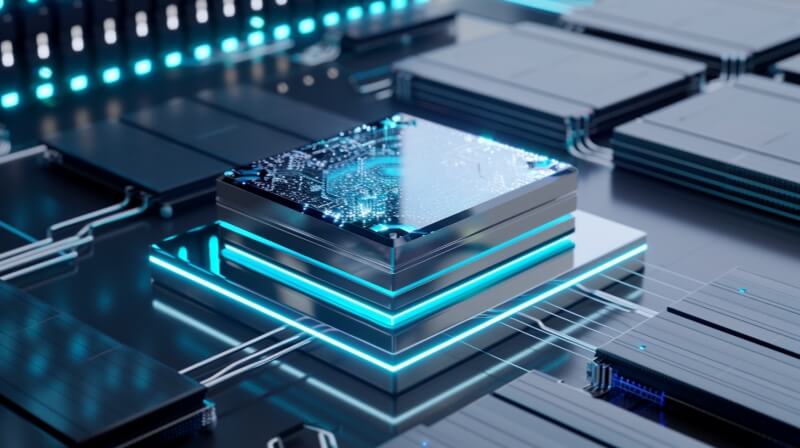Soaring rack power, rising energy bills and strict carbon caps squeeze every data centre. When fans and chillers hit their limits, cold-plate liquid cooling rescues performance—without wrecking budgets or uptime.
Let’s unpack why this matters, what the technology looks like, who supplies it, and how early adopters are already banking the savings.
AI clusters jam dozens of 500-watt accelerators into a single tray, spiking inlet temperatures and power use. Air stalls, chips throttle, and electricity bills soar. Procurement teams need a cooling method that scales with density yet slashes PUE and carbon footprints.
Cold-plate systems channel tempered water straight to every heat spreader, keeping silicon near 65 °C at 1 kW loads. Operators report cooling energy cuts of roughly one-third and rack capacities beyond 100 kW. Because plates stay inside standard chassis, the approach co-exists with other types of data center cooling systems, so upgrades can start rack by rack with minimal downtime.
Two factors drive adoption: efficiency and density. Liquid’s superior thermal conductivity means pumps draw a fraction of the power giant fans consume. Operators therefore reclaim megawatts for IT and shrink their carbon footprint. At the same time, cold plates allow vertically packed GPU trays without hot-spot worries, enabling >100 kW per rack—ideal for language-model training. Importantly, facilities can retrofit plate loops alongside legacy air handlers, minimising downtime. For teams measuring every watt, the business case is compelling.

Today’s plates resemble micro-reactors. Engineers sculpt internal channels with CFD and 3D printing, add turbulence fins, and coat surfaces against corrosion. Aluminium-SiC skins trim weight; copper-diamond composites boost conductivity. Even coolant chemistry evolves to stay low-viscosity while suppressing algae and galvanic attack.
Breakout advances include 3D-printed gyroid cores, diamond-loaded composites and warm-water operation. Asetek + Fabric8Labs recently showcased a printed plate that boosts heat transfer by roughly one-third, proving additive manufacturing can beat CNC geometries. Meanwhile, aluminium–SiC skins trim weight without losing conductivity. Together, these innovations let plates tame denser chips and enable liquid cooling systems for data center use in regions lacking chilled water plants.
Additive manufacturing frees designers from straight channels: lattice structures create turbulence at lower pressure drop, improving efficiency and pump life. Warm-water plates (inlet ≈30 °C) eliminate chillers entirely and open doors to heat-reuse schemes—office heating or absorption cooling—amplifying sustainability gains. High-hardness coatings now survive >20 years of glycol service, and blind-mate drip-less connectors simplify hot-swap maintenance. Collectively, these refinements mean fewer leaks, lighter racks and faster deployments, reinforcing cold plate viability for mainstream hyperscalers.
With providers from server OEMs to niche integrators, the selection list can overwhelm. Your mission: balance proven field data with flexibility, ensuring long-term support and supply-chain resilience. Evaluating on specs alone risks overlooking service quality and integration ease.
Start with a scorecard covering verified efficiency data, leak-free quick couplings, onsite commissioning help and transparent warranties. Prioritise suppliers publishing OCP-compliant manifolds so future servers slide straight in. For instance, XD THERMAL runs an ISO-certified line that precision-machines cold plates and pressure-tests every unit before shipment—without over-promising broader services.
Ask for third-party test reports, not brochure numbers. Check whether warranties cover pump vibration, coolant quality testing and connector cycles. Global spares hubs cut RMA delays, vital for multi-region estates. Finally, quantify total cost of ownership: hardware, water loops, heat-reuse credits and floor-space savings. The cheapest plate may cost more once service visits, downtime and retrofit kits enter the ledger. Experienced data centre cooling companies freely model these impacts, making ROI transparent.
Marketing claims mean little without proof, and procurement teams demand hard numbers. Luckily, hyperscalers and supercomputing labs have shared data that maps straight into CFO spreadsheets and ESG dashboards over the last three years.
Typical outcomes: JD Cloud racks cut cooling energy 45 % and shipped five times faster; Oak Ridge’s Frontier drives 40 MW of compute on 30 °C water at PUE 1.05; a 64-GPU Supermicro cluster saved roughly 40 % electricity while doubling density. Such results show cold plate data center upgrades often pay back in under two years
Savings ripple beyond electricity. Cooler chips sustain turbo clocks, accelerating AI training jobs and shortening time-to-model. Higher density defers costly building expansions. Some sites, like JD Cloud, circulate 40 °C outlet water through heat exchangers to warm offices, creating an extra revenue stream. Investors notice: Schneider Electric’s US $850 m purchase of Motivair underscores market confidence in plate-based liquid cooling systems for data center growth. For buyers, these case studies de-risk adoption and offer benchmarks when negotiating service-level agreements.
Processor roadmaps show 1.5 kW chips and rack densities topping 200 kW. Cold plates are evolving into two-phase hybrids, passive thermosyphons and AI-controlled pumps to tame that load while squeezing PUE below 1.05, both in cloud and edge facilities worldwide by 2027.

Expect smarter orchestration: embedded sensors feed machine learning that tweaks flow in milliseconds, trimming pump watts another 10 %. Standard blind-mate valves under OCP release will make hot-plug liquid loops routine. Regulatory pushes for heat reuse and common coolant specs will accelerate adoption across every cold plate data center build.
Industry consortia are drafting universal coolant specs to streamline cross-vendor qualification. Materials engineers pursue recyclable composites to cut embedded carbon. Meanwhile, government incentives for waste-heat reuse could offset installation costs, accelerating uptake in colder climates. As standards mature, procurement cycles will shorten and integration hurdles fall, making plate-based data centre liquid cooling as routine as raised floors once were.
For any cold plate data center project, liquid cooling now delivers density, efficiency and sustainability—inside standard servers. Equip yourself with the right partner, verified data and clear ROI modelling, then move early to bank energy savings and performance headroom before the next silicon leap arrives.